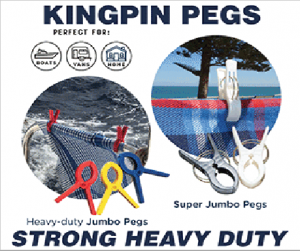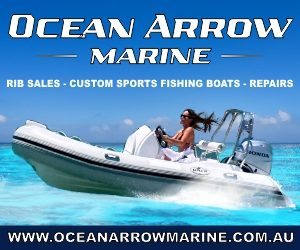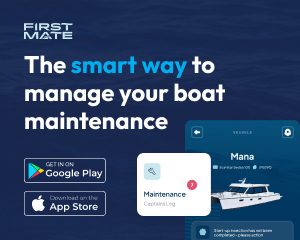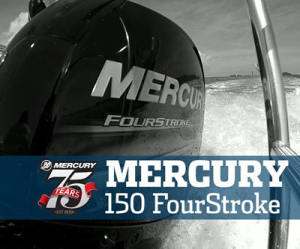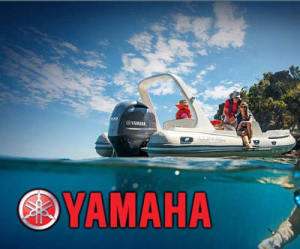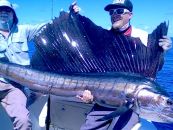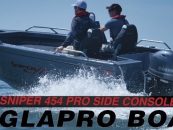What is fast, sleek, awesome on fuel, comfortable, will run in less than a foot of water, making it perfect for crossing shallow coastal bars, and comes with a stereo? Well, if you guessed a PWC, then you are right.
In Season One of the national outdoor and fishing television show Step Outside with Paul Burt, we partnered with BRP, through JSW Powersports, to have a go on what I believe is a watercraft that is changing the landscape of quick and easy fishing — the Sea Doo Fish Pro, the ultimate mini fishing weapon.
After collecting her from JSW Powersports in Labrador, I parked the ski up onto the driveway at home, unbolted the seat and engine covers, grabbed the grinder, ‘gently’ removed the ski pole tow hitch, and added in a heavy-duty fully welded rod holder capable of taking my Shimano 37kg bent butt trolling outfit. Now we are ready to go fishing!
I did not need to worry about a sounder as the Sea Doo Fish Pro comes pretty much fully loaded with a Garmin GPS/Sounder with a wet box glued to the inside of the hull. The hull houses the transducer, boarding ladder (in case you somehow fall off), and has direct access to the front storage locker. The rear platform of the ski has been extended for more stability and use, and the seating arrangement has been narrowed a touch making it quite comfortable on longer journeys. And that is something we have done in the past 12 months.
Getting to know the Fish Pro takes a little bit of practise, but not a lot. If you are a boatie like me and it is the first time driving one of these machines, you will instantly fall for it. The direct power of 170HP is at your fingertips. The ability of crossing a shallow coastal bar with ease and not even worrying about where the channel is or what the tide is doing makes it a pleasure when wanting to head out. The fuel tank can take in 70 litres, and if you add an extra 10 litres on the caddy that can attach to the back or placed underneath in the storage locker, those faraway places on a calm day become reachable.
When fishing on a jet ski, watching the weather is paramount. It is fair enough to say that she will handle some chop. But if you are a long way from home, trust me, every bone in your body will feel the banging, not to mention the huge amount of spray from the crosswind. In these conditions, it is not a nice feeling, and at that point, your hands would be very sore from holding on, steering and working the throttle. It is then that you would gladly swap her out for a comfy ride home in a helicopter. But then, when you get back and the wind drops the next day, you are sure to be out there again — because you are definitely hooked.
For me, it was a matter of using this PWC for what it was made — fishing the estuaries with my son, catching everything in there from flathead to squid, and crabbing for blue swimmers, to heading offshore on the local grounds spinning for tuna, live baiting for mackerel, micro-jigging for snapper, and the likes. But it is the next level where I wanted to take her, and that was where the rod holder I originally fixed through the hull came into play.
A few sessions out to sea started with round trips of 70kms of fishing the 24 and 36 fathom grounds; then the wider 42 fathom reefs for marlin, before pushing it to around a 90km return trip. The boundaries were endless! South to Windarra Banks off Brunswick Heads and Byron Bay, we went trolling for yellowfin, a 110km return trip. That day, I did not take 80W Tiagra, but instead opted for the lighter Shimano 24kg TLD 30 2-Speed, which worked a treat.
There is not a lot of storage room for your fish, but the purpose-built cooler of the Fish Pro’s purpose-built cooler houses heaps of fillets and plenty of smaller fish. It is the larger fish that can become a problem, so a fish chill bag is ideal as it lies perfectly down the inside gunwale. The cooler, by the way, has several points where removable rod holders can be attached, making it perfect for trolling a couple of rods out the back and storage for a net and gaff. When I say trolling a couple of rods, I am not talking about lightweight 2-4kg outfits; but rather, 15-24kg gear. They are super strong and have never bent, busted or un-clipped…yet!
Our next adventure pushed the limits even further. We crossed Moreton Bay, fished the Seven’s off Moreton Island, then headed south to the Wave Rider Buoy off Point Lookout, then further down to 50 fathom grounds off North Straddie. Dolphin fish or mahi mahi was the target species along with jigging for kingfish and amberjacks. As soon as we arrived at the spot, the sounder lit up like a Christmas tree, and it was on! That day, we went through around 70ltrs of fuel for a 140km round trip; not bad considering it got a bit choppy coming home through the bay.
Before long, a pandemic hit, the lockdown was imposed, the weather cooled a touch. Then eventually, restrictions were lifted for Queensland and high-pressure systems were lining up to move across Southeast Queensland. The weather was looking amazing for our next trip — cross Moreton Bay, round the Cape, before venturing south on the open ocean to the 70 fathom grounds for amberjacks, before sliding in closer to Deep Tempest, then Shallow Tempest for big mulloway.
When the Wave Rider Buoy measures waves to 2m, you can easily double it off Cape Moreton; it is an area that captures the bigger waves. Known for wrecks, ship containers, and underwater seamounts, this area is a perfect habitat for good quality fish. It has been that way for a long time, as it is a long way out, especially on a jet ski.
That trip was going to be around 170km return, so with the 70L-plus fuel capacity and an extra 15L, it would be enough. With the day being super calm, we could push the speed to over 80kph at times. It was fast! But when you turned the corner from Yellowpatch to the Cape, it chopped up. The waves were confused and all boxed up coming off the rocks, and the current was ripping.
After navigating around the green zones, the water calmed as we motored further out to sea. By 8am, the current dropped with the tide. It was a first-class day. Even at 60kph, I could read the bottom at speed on the Garmin Sounder. At that speed, one can cover good ground while looking for bumps, rocks and possibly ship containers on the bottom.
We located something on the sounder — a bump in 65m of water. I circled back and slowed down. The bottom was flat, a few fish came across the screen, then up rose a squarish shape with fish clouding the water around it. A mark was taken on the GPS. The bait jigs were dropped and baitfish instantly came up on the return. One slimey was hooked up and as soon as it descended back to the depths, there was no time to even put the reel into gear. It was just on! (It is worth pointing out that the easiest way to keep bait alive on the Fish Pro is by putting water inside the gunwale where your feet are positioned, and leave the bait in there to swim around.)
My Shimano Jewel PE3 matched with a Torium 10 was bent to the butt and pulling drag — no time for the second rod to be dropped down. The fish fought hard, and within a few minutes, there rose a quality silver jew or mulloway pushing 20kg. Rewarded with one fish, another drop was made. It was instantly on — this time a 15kg fish. Clearly, they were there in numbers and that was enough for me. Into the fish chill bag they slid.
The rest of the day consisted of some trolling in the sun on a calm ocean, listening to music, and quickly wondering what the rest of the world was doing — and at that single moment, I did not really care about anything.
By Paul Burt
Published in the August – November 2020 print edition.



